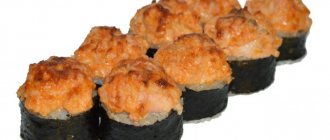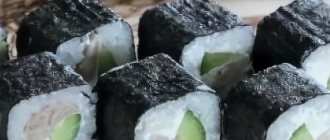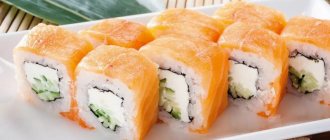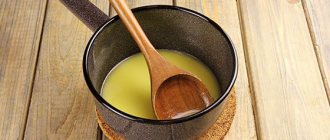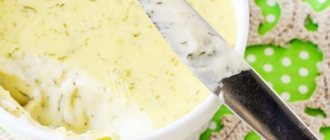Varieties of sushi
It is impossible to name all types of sushi, because there are so many of them that listing them would take almost an eternity. At the same time, we can indicate only some of their most popular types in Japan:
- Hosomaki - this roll consists of nori leaves and usually includes only one filling, most often cucumber or tuna;
- Nigiri-zushi - they contain boiled rice, which is often rolled into a small ball, as well as wasabi sauce. The classic look of this sushi excludes nori seaweed, but it can be found in some cooking recipes;
- Futomaki are small rolls, usually up to 6 centimeters in diameter. They consist of a sheet of nori and rice, and also have filling;
- Uramaki - the origin of such sushi occurred in the USA. They are interesting because their seaweed is on the inside and the filling is on the outside. Inventive Americans decided to come up with this recipe, since nori, in most cases, scares away its appearance and smell;
- Temaki - they are distinguished by their cone-shaped shape and large size. Temaki has seaweed on the outside and filling on the inside.
Step-by-step recipe with photos
To learn how to cook masterpieces of Japanese cuisine, you can first master a simple recipe for delicious maki sushi.
Products for classic maki sushi:
- Japanese rice - 1-2 cups;
- nori seaweed – 8 pcs.;
- lightly salted salmon without bones – 500 g;
- Philadelphia cheese – 150 g;
- fresh cucumber -2-3 pcs.;
- rice vinegar – 5 tbsp. l.;
- ginger - to taste;
- soy sauce;
- wasabi;
- salt, granulated sugar - to taste.
Preparation of ingredients:
- Rice grains must be washed in a bowl of water. The fluid must be changed until it becomes clear. This must be done so that after cooking the product is not covered with a film of starch.
- Place the rice in a deep pan with thick walls and fill it with water approximately 1:2. During the cooking process, water will be absorbed into the grains.
- Bring to a boil and set the container aside to let the rice steep for about 15-20 minutes.
- Salt and sugar dissolve in slightly heated vinegar.
- Hot rice is placed in a plastic container so that the layer lies evenly. Gradually add vinegar dressing to it, stirring with a wooden spoon.
- Cover the rice with a napkin and leave until completely cool.
- At this time, you can cut the ingredients for the filling into long, narrow strips: fish and cucumbers.
Formation of rolls:
- Cut the nori layer into two equal parts with scissors. Place one half, shiny side down, on a bamboo mat.
- Wet your hands in a bowl of water to which a few drops of vinegar have been added. Take 4 tablespoons of rice and distribute it evenly over the nori, leaving 1 cm from the top edge and 0.5 cm from the bottom. The rice layer should be approximately 7-8 mm.
- Place the toppings on top of the rice: a slice of cucumber, salmon, and Philadelphia cheese on top.
- Align the bottom edge of the nori with the edge of the mat, holding the filling. You need to slightly lift the mat and roll the maki sushi with upward and forward movements.
It’s worth knowing: before cutting the rolls, you need to dip the knife in water and vinegar, thanks to which the blade will easily slide through the rice.
Maki sushi is cut into two equal parts. Each half should be divided into three more rolls. Place the sliced rolls on a plate.
Ginger and wasabi are used as decoration.
At the time of serving, soy sauce should be poured into a separate cup.
Selection of fish for sushi
Most online stores can offer fish specifically designed for making sushi. If you buy it in a regular store, you can pay attention to both fresh and frozen fish. However, it is recommended to buy fresh, chilled.
Frozen sushi can only be purchased if the preparation of sushi is not delayed for several days. It is advisable to keep purchased fish on ice in the freezer.
You should also refer to general recommendations when purchasing fish. You should not take a product with an unpleasant smell of rot. In appearance, it should look neat, without strange stains or damage. You should also choose whole pieces, as they are easier to cut.
Features of preparing rice for sushi
Since rice cereal is one of the key products in the recipe for a Japanese dish, it is important to prepare it, taking into account all the nuances.
It is necessary to choose durum cereals; it is advisable to buy round rice. It should also be taken into account that there is a special rice grain for sushi, which differs from the usual one not only in its shape.
Rice should be washed more than 3 or 5 times. Japanese chefs claim that to prepare a quality dish, this must be done 7 times, or even more. During the final rinsing of the cereal, the water should be perfectly clear. Chefs also advise drying the rice a little before cooking.
As for the ratio of cereals and water, the most optimal is 1:1.5. When cooking, you must first wait until it boils, then cook for another minute and cover. The lid should not be removed so that the steam remains in the pan (this has a positive effect on the taste of the finished rice).
You need to cook for 15 minutes, then remove from the heat and leave the pan closed for a quarter of an hour. Sushi rice is completely ready after adding rice vinegar.
How to make sushi at home: the easiest recipe for beginners
| Ingredients | Quantity |
| Special mat for sushi - | 1 piece |
| Rice intended for rolls - | 200 g |
| Salted salmon - | 250 g |
| Avocado or cucumber - | 1 piece |
| Nori leaf - | 1 piece |
| Philadelphia cheese" - | 50 g |
| Cooking time: 60 minutes | Calorie content per 100 grams: 110 Kcal |
There is a recipe for this dish that is suitable for people new to the traditions of Japanese cuisine.
First you should cook the rice, taking into account all the recommendations indicated just above. Then unroll the nori sheet and spread the key filling with your hands. In this case, about 1-2 centimeters should remain from the edge of the sheet. It is also better to wet your hands before this procedure.
You need to distribute the cheese in the center of the resulting layer of rice. This can be done conveniently using a butter knife. The cheese track should be no more than 4-5 centimeters.
The salmon should be cut into oblong pieces and then placed on top of the cheese. Also, both avocado and cucumber can be used as a filling. In both cases, it is necessary to remove the skin from the fruit. It is better to cut the avocado into cubes, and the cucumber into strips. The vegetable filling should be placed on top of the fish.
Then you can form a roll by grasping the edge of the mat and starting to roll it inward. All that remains is to cut it into several equal pieces, the result should be about 8 pieces.
Philadelphia – making famous rolls easy
We offer a simple recipe for sushi at home from a classic set of products. Philadelphia is one of the popular types. By following simple recommendations, anyone can prepare a delicious treat.
Ingredients:
- Nori – 10 gr.;
- Salmon – 200 gr.;
- Sesame – 5 gr.;
- Philadelphia curd cheese – 200 gr.;
- Round boiled rice – 200 g;
- Fresh cucumber – 200 gr.
Philadelphia – making famous rolls easy
Preparation:
- To prepare the rolls according to the recipe, first cook and season the rice following the technology indicated above.
- Peel and cut the cucumber into strips of medium thickness. Cut the slightly frozen salmon into thin slices.
- Wrap the mat (bamboo mat) with cling film. Place a sheet of nori cut in half on it, with the rough side facing up.
- Now we form rolls at home using a step-by-step recipe. And first, spread a thin layer of rice with wet hands.
- Then, using a mat, flip the nori sheet over so that the rice is on the bottom.
- Place a line of soft cheese in the middle and place cucumber strips on it.
- Using a mat, form a roll.
- Place small slices of salmon on the remaining portion of the cling film.
- Similarly, wrap the roll with a mat so that a layer of fish forms on top.
- Sprinkle the resulting block with sesame seeds and cut it into 6-8 pieces with a wet knife. Place them on a serving platter.
California rolls have a similar cooking technology. The step-by-step recipe described above will help you prepare sushi at home. The only difference is that avocado and shrimp cut into strips are added to the soft cheese. Salmon with sesame seeds is replaced with red caviar, in which the formed roll is rolled.
Recipe for classic sushi rolls at home
Such sushi can be prepared from different types of fish, for example, salmon, eel, tuna, and so on. Vegetables can also be used instead of fish. For these rolls you will need the following components:
- Nori sheet – 1 piece;
- Rice intended for rolls – 100 g;
- Wasabi sauce – small amount;
- Eel – 200 g;
- Cucumber – 1 piece.
First of all, you need to prepare the sushi rice. Once it's ready, you can take the mat and place the nori on it, matte side up. After wetting your hands in water, spread the cooked rice over the nori sheet, leaving 3 centimeters of free space on the edge. If desired, the rice can also be coated with some wasabi sauce, the main thing is not to overdo it, as it is quite spicy.
You can put the filling on top. This will be eel, which must first be cut into oblong pieces, as well as peeled cucumber strips. It is better to place the fish on the bottom and the vegetable on top.
Now you can wrap the roll. To do this, you need to grab the edges of the mat and begin to twist the nori inward with both hands. It is advisable to roll with a little pressure; all components of the roll should be pressed tightly against each other.
All that remains is to cut the resulting sausage into equal portions.
You can eat classic sushi rolls by dipping them in soy sauce.
How to make sushi at home (26 photos + text)
I really like sushi. True, I don’t usually cook myself; I prefer to eat in restaurants. Making sushi at home is not as difficult as it might seem at first glance. And it doesn’t matter that it won’t turn out too beautiful the first time. This will not make them any less tasty. Over time, you will acquire the necessary skills and be able to make sushi easily and playfully. On average, the cooking process takes an hour and a half. Main types of sushi: 1. Nigiri (compressed sushi): Small, compressed finger-sized sticks of rice with a piece of fish on top. In sushi bars they are usually served in pairs.2. Maki (rolls): a combination of rice with any seafood and vegetables, rolled in a sheet of nori seaweed. Subsequently the roll is cut into pieces.3. Chirashi sushi (separate sushi): the most common type in Japan. The rice is placed into small containers and topped with a random combination of seafood and vegetables.4. Oshi-sushi (pressed sushi): Cooked or marinated fish is placed in the bottom of a small container, which is then filled to the brim with rice. A weight is placed on top of the rice. After some time, the workpiece is taken out, turned over with the fish up and cut into pieces.5. Mixed sushi: any other that does not fall into the above categories. For example, fukuza sushi is thin omelette squares used to wrap rice. Today we will learn how to prepare two types of sushi: nigiri and maki.
True, I don’t usually cook myself; I prefer to eat in restaurants. Making sushi at home is not as difficult as it might seem at first glance. And it doesn’t matter that it won’t turn out too beautiful the first time. This will not make them any less tasty. Over time, you will acquire the necessary skills and be able to make sushi easily and playfully. On average, the cooking process takes an hour and a half. Main types of sushi: 1. Nigiri (compressed sushi): Small, compressed finger-sized sticks of rice with a piece of fish on top. In sushi bars they are usually served in pairs.2. Maki (rolls): a combination of rice with any seafood and vegetables, rolled in a sheet of nori seaweed. Subsequently the roll is cut into pieces.3. Chirashi sushi (separate sushi): the most common type in Japan. The rice is placed into small containers and topped with a random combination of seafood and vegetables.4. Oshi-sushi (pressed sushi): Cooked or marinated fish is placed in the bottom of a small container, which is then filled to the brim with rice. A weight is placed on top of the rice. After some time, the workpiece is taken out, turned over with the fish up and cut into pieces.5. Mixed sushi: any other that does not fall into the above categories. For example, fukuza sushi is thin omelette squares used to wrap rice. Today we will learn how to prepare two types of sushi: nigiri and maki.
Ingredients 1. Sushi rice (short, rounded grains)
Some products close up:
Rice vinegar (su). It is highly advisable to use Japanese rice vinegar, which is mild and sweet. Chinese and especially Western brands are stronger and sour, and can overpower the delicate taste of sushi with their aroma. Mitsukan rice vinegar is the most suitable and is sold in many Asian stores.
Nori (seaweed). Usually sold in bags of 5-10 pieces, they are dark, crispy sheets measuring 20 x 18 cm. Used in making maki (rolls). The color is dark green and almost black. The black ones are more expensive, but also have a stronger aroma.
Raw fresh fish: salmon fillets (sake) and tuna (maguro). Under no circumstances should fish be frozen! It is advisable to buy something specially designed for sushi in Japanese stores, marked “sushi grade”.
Flying fish roe (masago). Arbitrary component. Mainly used to decorate the top of rolls or to coat the outside of the rolls when the rolls are cooked with the rice facing out (ura-maki).
Filling for rolls, any combination. For example, crab sticks, strips of avocado, cucumber and cream cheese. Additionally, you can use special Japanese mayonnaise (the regular one is too strong).
Cooking Rice for Sushi Rice, not fish, is the most important ingredient in sushi. The taste of the entire dish depends on whether it was prepared correctly. We are looking for Japanese style rice, with short, rounded grains. A regular long one won't work, it's very dry and therefore holds too much water. Recommended varieties: Nishiki, Kahomai, Maruyu, Kokuho and Minori.
1. Washing the rice. Typically, one cup of rice is enough for two people. But taking into account the fact that you will get a taste for it in the process of eating sushi prepared by yourself, it is better to proceed from the calculation of two cups. 2. Drain almost all the water. Stir again and squeeze the rice with your hand, this time firmly, but gently, without breaking, for 10 seconds. Fill with fresh water, squeeze, drain. Repeat one or two more times, the water should become almost clear. Drain.
3. Cooking rice. Place the washed rice in a deep pan. For each cup of rice, add 250 ml of cold water (in our case 500 ml). Close the lid, set the heat to maximum and quickly bring to a boil (takes about 5-7 minutes). Then, set the heat to minimum and leave for 12 minutes. After this time, the water will be completely absorbed into the rice and small ventilation holes will appear on its surface. Without removing the lid, remove the pan from the heat and let it brew for another 15 minutes.
4. While the rice is steeping, prepare a dressing for it. For two cups of rice you will need 50 ml of rice vinegar, 30 g of sugar and 10 g of salt. Dissolve sugar and salt in vinegar. You can preheat it slightly (very slightly!).
Nigiri br>While the rice is cooling, we need to cut the fish. There are 5 different cutting techniques for different types of sushi. But for nigiri, the technique of cutting fish at an angle is most suitable.
It is advisable to take a fish preparation of a rectangular shape, about 10 cm in length and 2.5 in height.
Forming nigiri. By this time the rice should have cooled down or be barely warm. Prepare a small plate of wasabi and vinegar water (tezu) to wet your hands (just pour boiled water into a bowl with a narrow mouth and add a couple of tablespoons of rice vinegar). When forming nigiri, your hands must always be wet, otherwise it will not work.
Carefully turn the nigiri over so that it rests on the fingertips of your left hand, fish side up. Now move it to the base of your fingers, while squeezing from the ends. Press the fish tightly into the rice.
Using the index finger of your right hand, scoop up a little wasabi (without releasing the rice from your palm) and lightly coat the piece of fish. Place rice on top. Using your left thumb, lightly press the top of the rice, leaving an almost imperceptible indentation. Now change hands and press more firmly onto the entire surface of the rice with the index and middle fingers of your right hand.
Nigiri is ready! Over time, you will learn to do them quickly and correctly. Make sure that the rice is not “pinched” and that the fish slices are always larger than the rice preparation and seem to cover it.
Rolls (maki) Rolls - “twisted sushi” - are formed using a bamboo mat (makisu). The filling can be anything you want. Usually this is any seafood in combination with vegetables (avocado, cucumber), Japanese mild mayonnaise or cream cheese. Using a mat, the rice and filling are rolled into a sheet of nori seaweed.
1. Thin rolls (hoso-maki). Thin rolls, about 2.5 cm in diameter, usually contain only one ingredient. To make them you will need half a sheet of seaweed (fold the sheet in half and cut with scissors). This half will make 6 pieces of sushi.
For rolls, simply cut the fish into narrow strips, or use the leftovers from cutting nigiri. Place half of the seaweed on the mat, shiny side down. Wet your hands with vinegar water. Take about 4 heaping tablespoons of rice and spread it over the surface of the seaweed. A free strip of about 1 cm should be left from the top edge, about 0.5 cm from the bottom. The height of the rice layer should be about 7 mm. Take your time, distribute the rice evenly, constantly wetting your hands. Using your index finger, rub a strip of wasabi down the middle of the rice. Top with toppings such as sliced tuna.
Align the bottom edge of the seagrass with the edge of the bamboo mat. Now, holding the filling in place, lift the edge of the mat using your thumbs as shown in the photo above. Continue lifting the mat up and forward until the edge rests on the opposite side of the seaweed. Fold the edge of the mat up, roll the roll back and forth and squeeze it a little inside the mat. Press the ends of the roll with your fingers if any rice falls out. Set the roll aside on a smooth surface and proceed to making the next one.
2. Thick rolls (futo-maki). Thick rolls, 5 cm in diameter, can contain up to 5 components. To make them, take a whole sheet of seaweed and place it on the mat, shiny side down. Wet your hands with vinegar water and spread the rice evenly over the seaweed, leaving about 2 cm free on the top side. If desired, coat the rice with mild mayonnaise.
While holding all ingredients, lift the edge of the mat using your thumbs and continue to lift it up and forward until the edge of the mat touches the opposite edge of the seaweed. Then, fold the edge of the mat up and “roll” the roll forward. Lightly squeeze it inside the mat, press it down with your fingers from the ends if the rice falls out. Set aside on a smooth surface and proceed to make the next one.
3. How to cut rolls. Take a sharp knife and dip the tip into vinegar water. Then, turn it with the tip up so that the water runs over the entire surface of the knife and evenly wets it. This will allow the knife to easily pass through the sticky rice without getting stuck in it.
As a result, you should get something similar to what is shown in the photo. When making rolls, especially futo-maki, you need to make sure that you don’t get a “snail” of seaweed inside. Such rolls are considered substandard, and show that the manufacturer has violated the principles of rolling rolls, and has not yet completely mastered the art of sushi making. Inside the rolls there should be nothing except rice with ingredients (as in the rolls in the lower right corner in the photo).
When making rolls, especially futo-maki, you need to make sure that you don’t get a “snail” of seaweed inside. Such rolls are considered substandard, and show that the manufacturer has violated the principles of rolling rolls, and has not yet completely mastered the art of sushi making. Inside the rolls there should be nothing except rice with ingredients (as in the rolls in the lower right corner in the photo).
Place the sushi on beautiful trays and pour soy sauce into ceramic cups.
You can dissolve a little wasabi in it if you want a more spicy sensation. You can also add a pickled ginger leaf to the sauce, but traditionally it is used to cleanse the palate of the taste of the previous piece of sushi. Grab the sushi with chopsticks, dip it into the sauce, let it soak for a few seconds and put it in your mouth. Bon appetit!
via mojbred.com
How to make Philadelphia sushi at home
It is “Philadelphia” that is the most popular type of fish delicacy in all countries. It is prepared on the basis of red fish and has a delicate delicate taste. To prepare it at home, you need to prepare the following ingredients:
- Rice intended for rolls – 400 g;
- Salmon or trout – 500 g;
- Avocado or cucumber – 1 piece;
- Granulated sugar – 1.5 tbsp. spoons;
- Philadelphia cheese - 250 g;
- Nori sheet - 3 pieces;
- Wasabi sauce.
After preparing the rice cereal, you can start creating rolls. One of the selected vegetables should first be peeled and cut into strips. The rug must first be wrapped in cling film. Place ½ sheet of nori on the mat, shiny side down.
Having wetted your hands in water in advance, you need to distribute the rice over the sheet, and also put pieces of chopped fish on top.
Now you need to turn the sheet over so that the fish is on the mat, and place avocado or cucumber strips on one of the edges of the nori. You should also coat the sheet with cheese next to it.
All that remains is to wrap the roll in the usual way, with the salmon on top. When cutting the resulting sausage, you will get about 7 sushi.
The choux pastry for dumplings with cottage cheese is particularly tender. Read how to properly prepare this dish.
Read how to cook steamed fish in a slow cooker to preserve all the beneficial microelements.
How to make caramel apples at home. This is an interesting dessert that both adults and children will enjoy.
Rolls "Mosaic" for culinary aesthetes
Classic varieties of rolls are widely popular. But culinary gurus are moving forward and surprising gourmets not just with taste, but also with aesthetics. “Mosaic” is considered one of these masterpieces. We suggest you learn more about how to prepare rolls at home.
Ingredients:
- Fish caviar – 12 tbsp;
- Fresh cucumber – 2 pcs.;
- Boiled rice – 250 gr.;
- Nori – 3 sheets;
- Philadelphia cream cheese - 10 tbsp.
Roll “Mosaic”: step-by-step recipe with photos
Preparation:
- Prepare sushi rice according to the recipe given above at home.
- Take a sheet of nori and cut off 1/3 of it. We lay most of it with the rough side up.
- Wet your hands and spread an evenly thin layer of rice.
- Place a washed whole cucumber on the base and form a roll with a mat.
- On the second sheet, cut off ¼. Mix 5 tbsp. caviar and 3 tbsp. rice On the larger part, laid out with the rough side up, we spread the prepared filling, place the cucumber preparation on top, and wrap it together in one roll.
- Cut the resulting thick briquette in half with a sharp knife. Turn each half cut side down and cut into 2 equal parts lengthwise.
- On the third large sheet of nori, place two parts of a thick roll, cut side down. Apply a stripe of cream cheese on top. We lay out the remaining 2 strips on it with their smooth backs facing inward.
- Using a mat, we form sushi rolls according to the recipe at home.
- The resulting briquette must be left for 5 minutes so that the rice holds the ingredients together.
- Using a sharp knife soaked in water, cut the briquette into 6-8 pieces and serve with Hiashi salad.
Sushi without nori at home: step-by-step recipe
Although this ingredient is used in almost all recipes, not everyone can appreciate its smell and taste. Therefore, you can prepare rolls that do not contain seaweed. They will require:
- Rice intended for rolls – 400 g;
- Avocado – 1 piece;
- Cucumber – 1 piece;
- Eggs (for batter) – 3 pieces;
- Mayonnaise (for batter);
- Vegetable oil - for frying.
Vegetables must be peeled and cut into strips. You should do the same with crab sticks; just cut them in half lengthwise.
After cooking the rice, you can spread it over the sushi mat, first covering it with cling film instead of nori. In this case, on one side the mat should remain 5 centimeters free, and on the other side - 20. Before this, you need to wet your hands. The second filling will be vegetables, which should be placed in the center of the rice. Now you can twist the roll by grabbing the edges of the sushi mat and cling film.
The next step is frying, which is a little unusual when preparing rolls. You need to cut each sausage in half to make it easier to place them in the pan. To prepare the batter, you need to beat mayonnaise and three raw eggs.
Then you should take the rolls with both hands, dip them in batter, and fry on each side until golden brown. All that remains is to cut the sausages into equal parts, allowing them to cool slightly first.
Lenten rolls - tasty and satisfying
There are times when eating animal proteins is not possible. In this case, we suggest preparing lean homemade rolls according to the recipe with step-by-step photos. The finished dish tastes just as good as varieties with fish filling. Do you have any doubts? Then it's time to try it for yourself!
Ingredients:
- Nori – 1 sheet;
- Rice – 150-200 gr.;
- Cucumber – 1 pc.
- Pepper – 0.5 red, 0.5 yellow;
- Avocado – 1 pc.;
- Sesame – 50 gr.;
- Soy sauce.
Lenten rolls - tasty and satisfying: recipe with photos
Preparation:
- Cook the rice until cooked, season.
- We prepare the mat: wrap it in cling film, grease it with a thin layer of sunflower oil, soak the excess with a paper towel.
- Lay out half a sheet of nori, textured side up. Apply a layer of rice to the seaweed and distribute it evenly. In this case, leave the far edge 1-2 cm.
- On the edge, somewhat closer to the middle of the side with rice, lay out a layer of sesame seeds in a thin strip.
- Cut the cucumber, avocado, and pepper into strips.
- Next to the sesame seeds, place a layer of cucumber straws, followed by slices of pepper.
- We begin to form a briquette using a mat. Roll up gradually, pressing the rice and filling lightly. Lightly moisten the remaining portion of nori without filling and glue the roll together.
- Using a similar technology, we prepare sushi with pepper and avocado at home. According to the recipe with photo, you can prepare a Lenten treat in a matter of minutes.
- Cut the finished briquettes into 6-8 pieces, serve with wasabi, pickled ginger and soy sauce.
Now you know how to prepare rolls at home. Recipes for classic, hot or vegetable treats can be supplemented and changed at your own discretion, surprising your loved ones with new culinary masterpieces.
3 dinners for two with free delivery for RUB 1,990.
View menu
